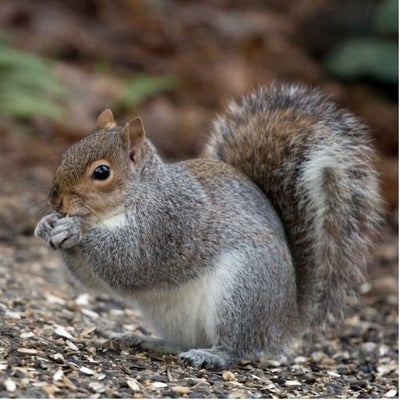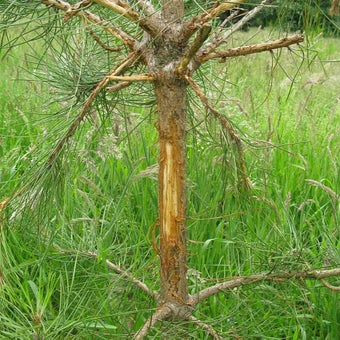
Quick facts
Common name - Grey squirrel
Scientific name - Sciurus carolinensis
Plants affected - Many ornamental plants, fruits and vegetables
Main symptoms - Strips bark from trees, eats flower buds, bulbs, corms, seeds, ripening fruits and vegetables
Most active - Year round
What are grey squirrels?
The grey squirrel is a rodent often seen in gardens and woodlands.
Grey squirrels are adaptable animals, they are omnivores feeding on material of plant and animal origin. In gardens they can cause concern when they damage ornamental plants, fruits and vegetables. Particular favourites are tulip , crocus corms, sweetcorn, strawberries, apples, pears, nuts, sunflower seed heads and flower of camellias and magnolias. Trees, including sycamore, maples, ash and beech, can be badly damaged or even killed by stripping. Grey squirrels will also take feed from bird feeders.
Symptoms
Grey squirrels are usually easily spotted. Some of the signs they have been present can include:
- Eating fruits, nuts, seeds, flower and vegetables
- Digging up and eating and corms
- Raiding bird feeders and occasionally taking eggs from birds’ nests
- Digging in lawns and flower beds to create and access food stores
- Strip bark off trees, especially sycamore, maples, ash and beech
- Gnawing on plastic, such as hosepipes, plant labels and plastic netting

Management
It is not possible to stop squirrels from entering a garden and it is usually necessary to accept and tolerate their presence or even appreciate their acrobatic antics. There are steps that can be taken to reduce the damage they cause. Additional information on living with grey squirrels can be downloaded from the RSPCA.
Netting can give protection to fruits and shrubs when squirrels are showing interest in them. Wire netting is best used for permanent structures such as fruit cages, as squirrels can quite easily bite through plastic. Netting can be placed over areas where and corms have been planted, to deter squirrels from digging them up. Alternatively groups of bulbs can be placed inside a planting basket designed for aquatic plants and the top covered with chicken wire. This can be sunk into the ground at the correct depth for the bulbs. Bulbs in pots can be protected with wire netting. Usually once bulbs have started growing, they become less attractive to squirrels and the barriers can be removed. To avoid accidentally trapping or injuring birds or other animals, please always ensure that netting is kept taut, and check regularly for holes.
Various designs of squirrel-proof bird feeders and tables are available from garden centres. These usually enclose the food dispenser in a stout wire cage that allows birds access while excluding squirrels. However, it may be found that birds also visit these feeders less frequently.
Animal repellent substances and scaring devices are likely to give no more than short-term protection.
Biology
The grey squirrel originates from North America and was introduced into Britain during the 19th century. It is now found throughout most of Britain and has largely replaced the red squirrel (Sciurus vulgaris). The decline of the red squirrel has been mostly caused by habitat changes and endemic diseases. The presence of the more competitive grey squirrel then hampers population recovery of the red squirrel. Increasing numbers of pine marten in the UK appears to be benefiting the red squirrel population as new research indicates they predate more on grey squirrels than red. However this control may be limted as the pine martens avoid urban areas, preferring a forest envirnoment.
With the exception of some areas of Italy, the grey squirrel is not found in Europe outside of Britain and Ireland.
Both species of squirrel can cause damage in gardens. However, if the red squirrel is seen in gardens it should be appreciated due to its rarity. The red squirrel has the highest level of protection under the Wildlife and Countryside Act.
Grey squirrels can produce two litters a year, which are raised in nest-like structures called dreys. Litters are generally produced in February and July; a typical litter size is three or four. Grey squirrels are active throughout the year on all but the coldest days.
Most stripping appears to be associated with stress brought on by territorial disputes with other squirrels. It is more likely to happen when squirrel numbers are high and there is increased competition for territories.
Like all animals squirrels can suffer a variety of diseases, if you find a dead or dying squirrels you can report it on the Garden Wildlife Health website.










